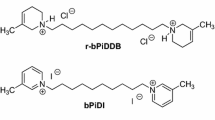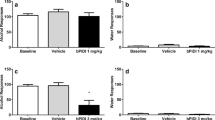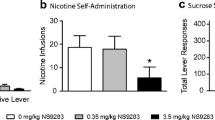Abstract
Rationale and objective
Recent work has shown that the novel compound N,N′-dodecane-1,12-diyl-bis-3-picolinium dibromide (bPiDDB) may selectively block nicotinic acetylcholine receptors involved in regulating dopamine release. The current experiments examined the acute effect of bPiDDB on nicotine self-administration, sucrose-maintained responding, and nicotine-induced changes in acute and sensitized locomotor activity.
Methods
Rats were first trained to respond for either nicotine (i.v.) or sucrose pellets using a standard two-lever operant conditioning procedure using a fixed ratio 5 schedule of reinforcement and were then pretreated with bPiDDB (0, 0.3, 1, or 3 mg kg−1) 15 min prior to the session. In separate experiments, rats were assessed for nicotine-induced changes in locomotor activity following pretreatment with bPiDDB (1 or 3 mg kg−1) or mecamylamine (1 mg kg−1); pretreatments were assessed with both acute and repeated nicotine (0.4 mg kg−1) treatment.
Results
Results showed that bPiDDB dose-dependently decreased nicotine self-administration, but not sucrose-maintained responding. In the locomotor experiments, bPiDDB attenuated the hyperactivity produced by acute and repeated nicotine; however, this effect was not robust compared to mecamylamine. In contrast to mecamylamine, bPiDDB did not block the initial hypoactivity produced by acute nicotine.
Conclusion
Since bPiDDB decreased nicotine self-administration specifically, this novel nicotinic receptor antagonist may constitute a lead for the development of a clinically useful treatment for tobacco dependence.







Similar content being viewed by others
References
Ayers JT, Dwoskin LP, Deaciuc AG, Grinevich VP, Zhu J, Crooks PA (2002) bis-Azaaromatic quaternary ammonium analogues: ligands for alpha4beta2* and alpha7* subtypes of neuronal nicotinic receptors. Bioorg Med Chem Lett 12:3067–3071
Balfour DJ, Benwell ME, Birrell CE, Kelly RJ, Al-Aloul M (1998) Sensitization of the mesoaccumbens dopamine response to nicotine. Pharmacol Biochem Behav 59:1021–1030
Benwell ME, Balfour DJ (1992) The effects of acute and repeated nicotine treatment on nucleus accumbens dopamine and locomotor activity. Br J Pharmacol 105:849–856
Clarke PB, Kumar R (1983) The effects of nicotine on locomotor activity in non-tolerant and tolerant rats. Br J Pharmacol 78:329–337
Corrigall WA, Coen KM (1989) Nicotine maintains robust self-administration in rats on a limited-access schedule. Psychopharmacology (Berl) 99:473–478
Corrigall WA, Franklin KB, Coen KM, Clarke PB (1992) The mesolimbic dopaminergic system is implicated in the reinforcing effects of nicotine. Psychopharmacology (Berl) 107:285–289
Cummings KM, Hyland A (2004) Impact of nicotine replacement therapy on smoking behavior. Annu Rev Public Health
Damaj MI, Martin BR (1993) Is the dopaminergic system involved in the central effects of nicotine in mice? Psychopharmacology (Berl) 111:106–108
Dews PB (1955) Studies on behavior. I. Differential sensitivity to pentobarbital of pecking performance in pigeons depending on the schedule of reward. J Pharmacol Exp Ther 113:393–401
Donny EC, Caggiula AR, Mielke MM, Booth S, Gharib MA, Hoffman A, Maldovan V, Shupenko C, McCallum SE (1999) Nicotine self-administration in rats on a progressive ratio schedule of reinforcement. Psychopharmacology (Berl) 147:135–142
Dwoskin LP, Sumithran SP, Zhu J, Deaciuc AG, Ayers JT, Crooks PA (2004) Subtype-selective nicotinic receptor antagonists: potential as tobacco use cessation agents. Bioorg Med Chem Lett 14:1863–1867
Epping-Jordan MP, Picciotto MR, Changeux JP, Pich EM (1999) Assessment of nicotinic acetylcholine receptor subunit contributions to nicotine self-administration in mutant mice. Psychopharmacology (Berl) 147:25–26
Grottick AJ, Trube G, Corrigall WA, Huwyler J, Malherbe P, Wyler R, Higgins GA (2000) Evidence that nicotinic alpha(7) receptors are not involved in the hyperlocomotor and rewarding effects of nicotine. J Pharmacol Exp Ther 294:1112–1119
Ksir C (1994) Acute and chronic nicotine effects on measures of activity in rats: a multivariate analysis. Psychopharmacology (Berl) 115:105–109
Lundahl LH, Henningfield JE, Lukas SE (2000) Mecamylamine blockade of both positive and negative effects of IV nicotine in human volunteers. Pharmacol Biochem Behav 66:637–643
Markou A, Paterson NE (2001) The nicotinic antagonist methyllycaconitine has differential effects on nicotine self-administration and nicotine withdrawal in the rat. Nicotine Tob Res 3:361–373
Miller DK, Wilkins LH, Bardo MT, Crooks PA, Dwoskin LP (2001) Once weekly administration of nicotine produces long-lasting locomotor sensitization in rats via a nicotinic receptor-mediated mechanism. Psychopharmacology (Berl) 156:469–476
Miller DK, Sumithran SP, Dwoskin LP (2002) Bupropion inhibits nicotine-evoked [(3)H]overflow from rat striatal slices preloaded with [(3)H]dopamine and from rat hippocampal slices preloaded with [(3)H]norepinephrine. J Pharmacol Exp Ther 302:1113–1122
Morrison CF (1967) Effects of nicotine on operant behaviour of rats. Int J Neuropharmacol 6:229–240
Panagis G, Kastellakis A, Spyraki C, Nomikos G (2000) Effects of methyllycaconitine (MLA), an alpha 7 nicotinic receptor antagonist, on nicotine- and cocaine-induced potentiation of brain stimulation reward. Psychopharmacology (Berl) 149:388–396
Paterson NE, Semenova S, Gasparini F, Markou A (2003) The mGluR5 antagonist MPEP decreased nicotine self-administration in rats and mice. Psychopharmacology (Berl) 167:257–264
Phillips G, Willner P, Sampson D, Nunn J, Muscat R (1991) Time-, schedule-, and reinforcer-dependent effects of pimozide and amphetamine. Psychopharmacology (Berl) 104:125–134
Picciotto MR, Zoli M, Rimondini R, Lena C, Marubio LM, Pich EM, Fuxe K, Changeux JP (1998) Acetylcholine receptors containing the beta2 subunit are involved in the reinforcing properties of nicotine. Nature 391:173–177
Rauhut AS, Mullins SN, Dwoskin LP, Bardo MT (2002) Reboxetine: attenuation of intravenous nicotine self-administration in rats. J Pharmacol Exp Ther 303:664–672
Rose JE, Behm FM, Westman EC, Levin ED, Stein RM, Ripka GV (1994) Mecamylamine combined with nicotine skin patch facilitates smoking cessation beyond nicotine patch treatment alone. Clin Pharmacol Ther 56:86–99
Rose JE, Westman EC, Behm FM, Johnson MP, Goldberg JS (1999) Blockade of smoking satisfaction using the peripheral nicotinic antagonist trimethaphan. Pharmacol Biochem Behav 62:165–172
Shoaib M, Schindler CW, Goldberg SR (1997) Nicotine self-administration in rats: strain and nicotine pre-exposure effects on acquisition. Psychopharmacology (Berl) 129:35–43
Slemmer JE, Martin BR, Damaj MI (2000) Bupropion is a nicotinic antagonist. J Pharmacol Exp Ther 295:321–327
Teng L, Crooks PA, Buxton ST, Dwoskin LP (1997) Nicotinic-receptor mediation of S(−)nornicotine-evoked [3H] -overflow from rat striatal slices preloaded with [3H] -dopamine. J Pharmacol Exp Ther 283:778–787
Watkins SS, Epping-Jordan MP, Koob GF, Markou A (1999) Blockade of nicotine self-administration with nicotinic antagonists in rats. Pharmacol Biochem Behav 62:743–751
Acknowledgements
This work was supported by USPHS grant U19 DA17548 and by NIDA training grant T32 DA07304. We acknowledge the excellent technical assistance of Laura Fenton and Andrew Meyer and the expert advice of Dr. William Corrigall. For purposes of full disclosure, the University of Kentucky holds patents on bPiDDB, and a potential royalty stream to LPD and PAC may occur consistent with the University of Kentucky policy.
Author information
Authors and Affiliations
Corresponding author
Rights and permissions
About this article
Cite this article
Neugebauer, N.M., Zhang, Z., Crooks, P.A. et al. Effect of a novel nicotinic receptor antagonist, N,N′-dodecane-1,12-diyl-bis-3-picolinium dibromide, on nicotine self-administration and hyperactivity in rats. Psychopharmacology 184, 426–434 (2006). https://doi.org/10.1007/s00213-005-0163-8
Received:
Accepted:
Published:
Issue Date:
DOI: https://doi.org/10.1007/s00213-005-0163-8




